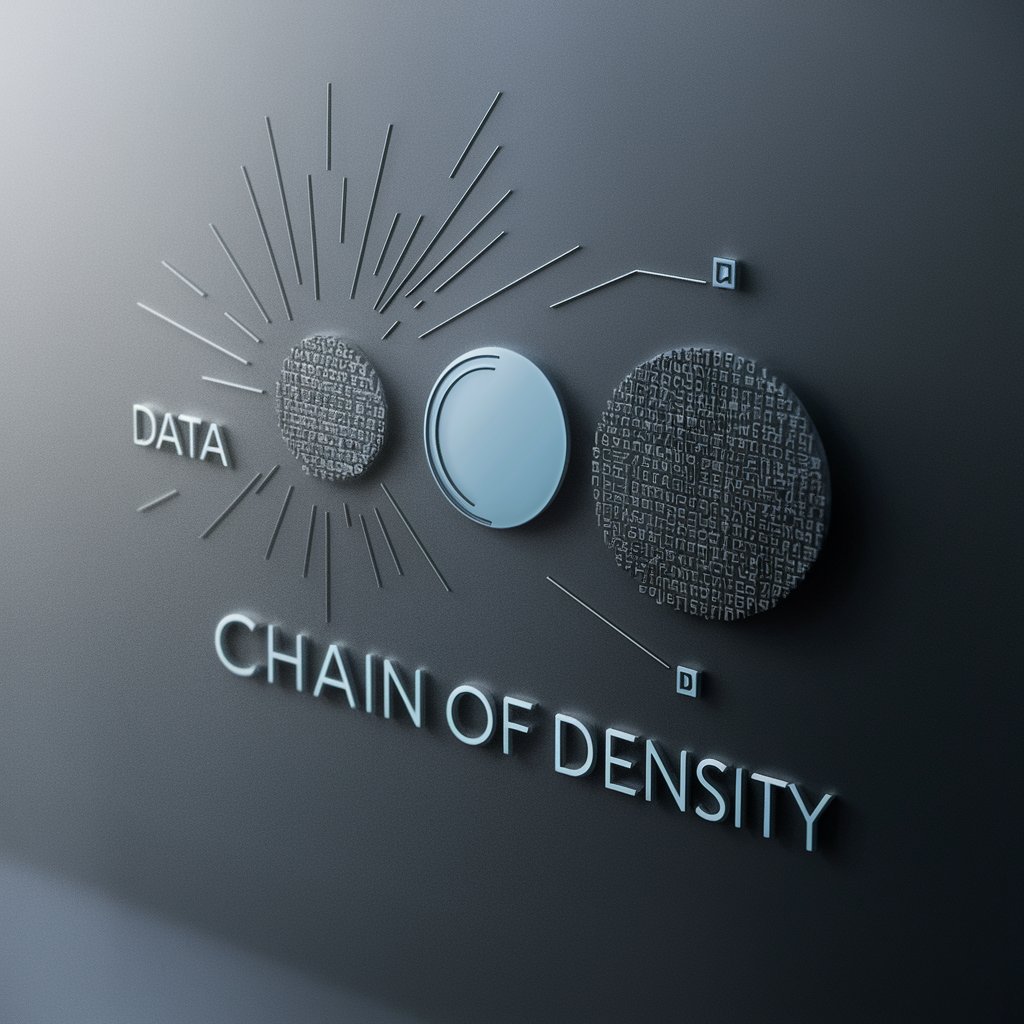Chain of Density - Article Summarization in JSON - Dense Information Summarization

Welcome to Chain of Density! Let's optimize your summaries.
AI-Powered Precision in Every Summary
Generate increasingly concise summaries by...
Incorporate missing entities iteratively...
Rewrite summaries to include more details without...
Identify and fuse missing entities into...
Get Embed Code
Introduction to Chain of Density - Article Summarization in JSON
Chain of Density - Article Summarization in JSON is designed to offer a novel approach to generating summaries by increasing information density without expanding the summary length. It iteratively incorporates missing salient entities into an initial summary, ensuring each new version is denser and more informative while maintaining the same word count. This method is rooted in the belief that a good summary should strike a balance between being detailed and concise, offering readers a rich, entity-centric narrative without overwhelming them with excess verbosity. For example, in summarizing a news article about a technological breakthrough, the first summary might mention the breakthrough itself and the company behind it. Subsequent iterations could add the technology's potential impact, key individuals involved, and specific advancements, all without increasing the summary's length. This approach is particularly useful in contexts where concise and rich information delivery is crucial, such as in news aggregation or academic research. Powered by ChatGPT-4o。

Main Functions of Chain of Density - Article Summarization in JSON
Iterative Densification
Example
Starting with a sparse summary of an event, additional details like specific dates, locations, and participant names are incrementally included in subsequent iterations.
Scenario
In a scenario where a journalist seeks to provide a concise yet comprehensive overview of a complex political event, using iterative densification, they can ensure the summary remains compact while progressively incorporating critical details.
Entity Recognition and Integration
Example
Identifies key entities (people, places, technologies) missing from the initial summary and integrates them into the next version.
Scenario
When creating a summary for an academic paper, this function allows the summarizer to highlight essential methodologies, findings, and researchers' names, ensuring that each iteration becomes more informative.
Compression and Abstraction
Example
Transforms verbose descriptions into concise phrases without losing meaning, allowing for the addition of new information.
Scenario
In summarizing user reviews for a product, this function could distill long narratives into succinct summaries, capturing the essence of user sentiments while making room for diverse opinions.
Ideal Users of Chain of Density - Article Summarization in JSON Services
Content Curators and Journalists
Professionals who need to quickly synthesize and relay complex information in an accessible format. They benefit from being able to produce rich, dense summaries that capture the essence of articles or reports without requiring readers to delve into full texts.
Researchers and Academics
Individuals in these fields often face information overload. Chain of Density helps them to create or access concise summaries of relevant literature, facilitating quicker understanding of key findings and methodologies across numerous publications.
Product and Business Analysts
Analysts can utilize the service to summarize vast amounts of user feedback or market research data, enabling them to present actionable insights succinctly to stakeholders or in reports.

Using Chain of Density - Article Summarization in JSON
Step 1
Visit yeschat.ai for a free trial without login, also no need for ChatGPT Plus.
Step 2
Input the text of the article you wish to summarize in the designated field.
Step 3
Select the 'Chain of Density' summarization option to initiate the process.
Step 4
Review the iterative summaries provided, noting the increasing density of information.
Step 5
Use the final JSON formatted summary for your specific application, such as research or content creation.
Try other advanced and practical GPTs
! Luxury Connoisseur !
Elevating Luxury with AI-Powered Insights

Love Language Liaison
Unlock Deeper Connections with AI-Powered Love Language Insights

AI Diagram Designer: Smart Mind Map & Chart Maker
Visualize Ideas with AI Precision

Macro Photography Maestro
Elevate Your Macro Shots with AI

African History
Unlocking Africa's Rich Heritage with AI

Medicus
Empowering Healthcare with AI

WhatCar
Identify any car with AI-powered precision.

BookWorm
Unlocking Knowledge with AI-Powered Summaries

GPT Calendar and Email Scheduler
Streamline Scheduling with AI Precision

Audience Finder
Discover Your Audience, Expand Your Reach

Trail Guide
Navigate the Wild with AI-Powered Guidance

Linguist Lens
Empowering Communication with AI

FAQs about Chain of Density - Article Summarization in JSON
What is Chain of Density summarization?
Chain of Density summarization is a process where an article is summarized iteratively, with each iteration increasing the information density without extending the length.
How does this tool differ from traditional summarization methods?
Unlike traditional methods that focus on reducing content length, this tool maintains a constant length while progressively incorporating more detailed and specific entities into the summary.
Can Chain of Density handle articles of any length?
Yes, it can process articles of varying lengths, but the effectiveness may vary depending on the complexity and information density of the original article.
Is the summarization output customizable?
The tool provides a structured JSON output, which users can customize according to their needs, especially useful for integration with other applications.
What are common applications of this summarization tool?
Common applications include academic research, content creation, data analysis, and information aggregation for quick reference.
